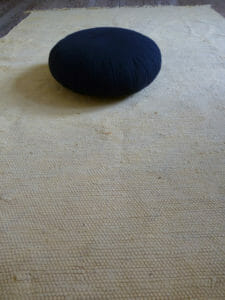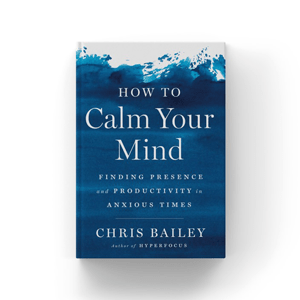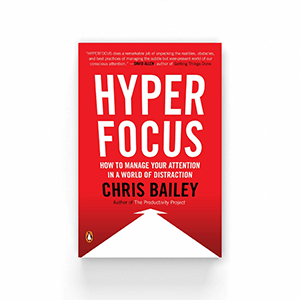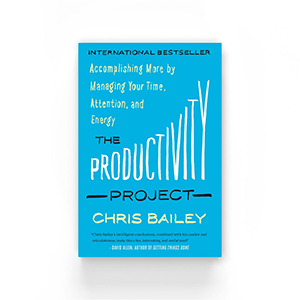Estimated Reading Time: 11 minutes, 16s.

My goal with this guide is to give you everything you need to start a meditation practice to become more productive. Meditation is a simple practice, but it’s one that seems intimidating on the surface. This article focuses on meditation as it relates to productivity, and reduces meditation to its most basic elements. My goal with it is to provide a simple, secular overview of everything you need to start meditating.

Meditation will make you more productive. It might sound strange that sitting still and doing nothing for a period of time will make you more productive, but it’s true. Before diving into what to do, it’s worth going over why you should meditate in the first place.
I’ve combined benefits observed by neurological research with my own personal observations over the three years I’ve been meditating (which are slightly less scientific). Some benefits of meditation include:
- Meditation has great calming effects. Research has shown that EEG activity actually decreases during meditation.1 Meditation also helps you to recharge so you have more energy throughout the day.
- The practice increases the blood flow in your brain, and according to one neurophysiologist, “rewires the circuitry in your brain”. 2
- It’s been proven that people who meditate need less sleep.3
- Meditation makes your brain age slower and increases the amount of grey matter in your brain.4 Grey matter is responsible for muscle control, seeing, hearing, memory, emotions, and speech.5
- Meditation makes it much easier to focus and achieve flow, that feeling of being completely immersed and energized by something. It also allows you to procrastinate less, and get more done in the same amount of time.
- The practice has been even shown to boost students’ test scores (by 11% in one study)!6
- Meditation helps your mind defragment your thoughts so you can make better sense of them, and step away from them to gain perspective.
Needless to say, there are a ton of benefits to adopting a regular meditation practice, and these are just a few of them.

Meditation is a very simple practice that people overcomplicate. This article focuses on breathing meditation, where you focus on your breath. (Imagine that!)
The basic idea of meditation is simple. Every time your mind begins to shift its spotlight away from your breath and you get lost in thought, you simply bring your attention back to your breath. And then you repeat this again and again until your meditation timer sounds. The point is that every time you bring your attention back to your breath, you work out your “attention muscle”, if you want to call it that. Then, over time your focus, concentration, and attention span improve, in addition to the plethora of other benefits mentioned above.
That’s the basic idea of meditation.
You will need two things to get started, but you should have both of them already.

You don’t need much to meditate, but you should have two things:
- Something to sit on. There is such thing as standing meditation and walking meditation, but sitting meditation is the most common and the best place to start.
- A timer. Since meditation is all about working out your “attention muscle”, having to check a clock would somewhat defeat the purpose of meditation, since it would constantly distract your attention away from your breath.
1. Something to sit on
There are three options for something to sit on during meditation.
A chair (good if you’re starting out or have back problems)
Chairs are great for if you’re just starting to meditate, or if you have back problems and find sitting on a meditation cushion uncomfortable. If you’re new to meditation, I recommend using a chair the first few times instead of going out and buying a meditation cushion. Once you routinize meditation and become more comfortable with it, then I would recommend purchasing a meditation cushion; using a chair at first will help you ease your way into practice.

A meditation cushion (zafu). I use mine on top of a soft mat to make it easier on my feet.
A meditation cushion (most common)
A meditation cushion (named a “zafu”, pictured right) is the most popular thing people sit on during meditation. The great thing about a meditation cushion is it is easiest to sit in an upright position when you’re on one, which improves your alertness and the quality of your meditation (and hence, how productive your sit is). With a chair or a meditation bench, you may be tempted to slump, which can cause you to lose focus.
A meditation bench (more comfortable than a cushion)
If you’re taller or find a meditation cushion too uncomfortable, it’s worth giving a meditation bench a shot. It will still force you to sit upright, and you won’t have the urge to slump as much as you do on a chair. Meditation benches also absorb a lot of the weight you would have otherwise applied to your legs, which makes meditation much more comfortable.
Recommendation
I recommend that you sit on a chair the first several times you meditate, and then switch to a meditation cushion (zafu) after you become more comfortable with your practice.
A meditation cushion will keep you the most alert during your meditation, but you likely don’t have one lying around your house already. It also takes your body a while to adapt to sitting on one, which will make you sore when you first start out. If you’re relatively fit and healthy, though, I recommend using a cushion for the alertness it will give you.
If you have leg problems, or are just looking for something a little more comfortable than a meditation cushion, I recommend using a bench. If you have back problems, I recommend using a chair – but be careful, because though chairs are more comfortable, it’s easier to lose focus on one.

Meditate for iPhone.
2. A timer
The second thing you’ll need is a timer.
I recommend that you simply use your phone, but just make sure to turn your phone’s radio off before you begin meditating. Pretty much every phone has a timer built-in, and if you have a smartphone, chances are there is a great meditation app for it too.
- Insight Timer is a good pick, and there’s a free version of it available for iPhone and Android. You can even see who around the world is meditating when you are!
- If you’re willing to pony up a few bucks ($3.99), Meditate for iPhone is a good pick, and it’s the one I use. It’s dead-simple, and displays a simple page of stats after you finish.
I wouldn’t recommend buying an actual, physical meditation timer. When a free app that works on your phone accomplishes the exact same thing, I don’t personally see a point.

When I first started to meditate, I remember being dumbfounded at what exactly I had to do after I sat down. Two things especially confused me: how do I sit, and what do I think about? Those are essentially the only things you need to worry about when it comes to meditation.
How to sit
 The biggest thing to remember is to keep your back straight. Keep your back erect (if you’re in a chair it’s best not to rest your back on the back of the chair), and keep an upright posture. This keeps you alert, and allows you to concentrate more easily on your breath.
The biggest thing to remember is to keep your back straight. Keep your back erect (if you’re in a chair it’s best not to rest your back on the back of the chair), and keep an upright posture. This keeps you alert, and allows you to concentrate more easily on your breath.- Your eyes can be either closed or open. Again, the goal of this whole “meditation” thing is to work out your attention muscle. If you find you can concentrate better on your breath with your eyes closed, as many people do, then it’s probably best to keep them closed. If you’re tired and find yourself dozing off when you close your eyes, try opening them slightly and focusing your gaze softly on a space on the floor in front of you. For me, this becomes distracting, so I keep them closed and only open them if I’m tired.
- Don’t worry about your hands. Some people like to form circles with their thumb and another finger, but that doesn’t really matter, in my opinion. I usually just rest my hands, palm down, on my legs, wherever they feel the most comfortable.
- Cross your legs however you want. I usually cross my legs in front of me, and I think that works fine for most people. If you want to fold your feet like a pretzel you can, but if you use meditation to strengthen your attention muscle, it may be easiest to keep to a simple, cross-legged pose.
- Look slightly downward, even if your eyes are closed. This opens up your chest. Again, though, find a place that’s comfortable – one that keeps you upright and opens up your chest at the same time.
- The biggest point I can make about how to sit is to find a pose and posture that’s both comfortable and keeps you upright. The guidelines above work best for me and most of the people I know, but they may not work for you. The most comfortable meditation pose will give you so little alertness that it will put you to sleep, and the least comfortable pose will keep you alert, but at the expense of your comfort. The best advice I can give is to try to find a place in between that works the best for you.
What to do
The attention you give the different things around you is a spotlight, and all day you move it around and point it at different things, usually without thinking too much about the fact that you’re doing this. As you move it around, you point it at everything you give attention to in your life, from your smartphone, to a conversation you’re having, to a report you’re writing. And a lot of the time, you direct it at more than one thing at a time. Actually, most of the time you do.7
Meditation takes that “spotlight” that is your attention and it points it directly at your breath.

So that’s all well and good, but what do you do, exactly? Six things.
- Get comfortable. Open the timer on your phone, and get into an upright and comfortable posture. Dim the lights a bit, or shut them off completely to help you focus better.
- Start your timer.
- Bring your attention/focus to your breath. This is what meditation is all about, and this is what makes meditation both difficult and worthwhile. In this third step, close your mouth and focus entirely on your breath as it enters and leaves your nose. You can focus on any element of your breath that you want – from how the air feels as it enters and exists your nose, to how the air feels as you inflate and deflate your lungs, to the sensation under your nose as you breathe in and out, to the sound you make as you breathe. Don’t force your breathing here – just breathe naturally and observe your breath without thinking too much about it.
- Don’t think. This is the hard part. Don’t analyze your breath; just bring your attention and focus to your breath, without thinking about it or analyzing it.
- Bring your attention back to your mind when it wanders. And it will. I’ve been meditating for 3-4 years for 30 minutes a day, and my mind still wanders sometimes. When your mind wanders, and it will, gently bring your attention back to your breath once you realize that your mind has wandered. You may not clue in at first that your mind has started thinking again, but when you do, gently bring your attention back. Don’t be hard on yourself during this stage. Just gently bring your attention back.
- Again, bring your mind back when it wanders. When your mind begins to think, gently bring your attention back to only your breath. When your mind begins to think about how boring meditation is, gently bring your attention back to your breath. When your mind becomes restless, bring in your attention again. Keep doing this until your meditation timer sounds.

- Meditating for 10 minutes a day is infinitely better than meditating for 70 minutes once a week. Try to meditate frequently (every day if possible), even if that just means sitting for a few minutes.
- Start small. If you try to meditate for 30 minutes right from the start, I can almost guarantee that you will get frustrated and discouraged. I recommend starting with five minutes, and only increasing that time when you’re comfortable. Even if you sit for five minutes, and you find that your mind wanders the whole time, you will still receive incredible benefits from meditation.
- Pick a gentle alarm. If your timer is loud and jarring, anticipating the alarm will distract your attention during meditation.
- Meditate in a quiet place. Having less distractions around you will naturally allow you to concentrate better, and will make your meditation much more productive.
- It’s easiest to lose your attention during your out-breath. Your in-breath is very pronounced and easy to concentrate on, and most people’s minds wander on their out-breaths (me included). This is worth keeping in mind.
- Be easy on yourself when your mind wanders. It’s easy to become frustrated with yourself when your mind wanders, but don’t. Your meditations will be much more productive when you gently bring your attention back.
- If you can’t concentrate, try counting. Count your breaths, until you reach five, and then start again. I use this trick when I’m having a tough time concentrating.

My goal with this guide was to give you everything you need to start up a meditation practice. Meditation is a simple practice, but it’s one that seems intimidating on the surface. If you are have questions about breathing meditation, please post a comment below, or tweet at me! There is also a twitter hashtag, #OMCru (which stands for Online Meditation Crew). I know of a lot of people that follow this hashtag, so if you post a meditation question with it, you are bound to get an answer.
Thanks a lot for reading, and happy meditating!
Zafu image at top by Roberto Poveda.
Source: “Meditation states and traits: EEG, ERP, and neuroimaging studies“ ↩
Source: Zen and the Brain book ↩
Meditation acutely improves psychomotor vigilance, and may decrease sleep need. Prashant Kaul, Jason Passafiume, R C Sargent and Bruce F O’Hara. Behavioral and Brain Functions 2010, 6:47 doi:10.1186/1744-9081-6-47 ↩
Source: Meditation Associated With Increased Grey Matter In The Brain ↩
Source: http://en.wikipedia.org/wiki/Grey_matter ↩
Source: http://well.blogs.nytimes.com/2013/04/03/how-meditation-might-boost-your-test-scores/ ↩
Attention is a weird beast. A bird watcher and a hiker will look at the exact same forest and see something completely different. If you talk to both the bird watcher and the hiker later in the day and ask them what they saw, they will both have a completely different story for you because they both paid attention to different things. The bird watcher will tell you about the beautiful cardinals and rainbow lorikeets he saw that caught his attention, and the hiker will tell you about the beautiful trails that went on for miles. ↩




